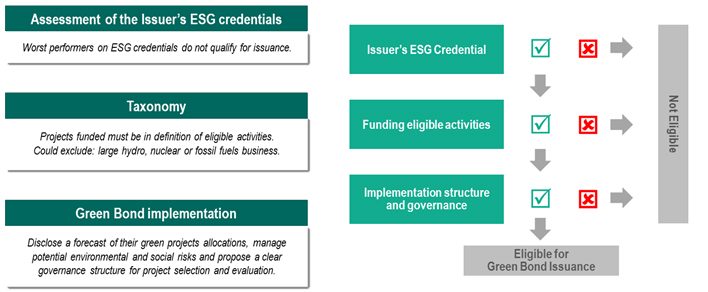As the international community moves towards the COP21 and Paris agreement goal of limiting global warming to a maximum of 2oC, there is a need for investments in green projects across industries and geographies to limit CO2 emissions. Such projects can be increasingly financed through the issuance of dedicated instruments leveraging their environmental and sustainability objectives.
Multiple responsible investors across the globe have decided to incorporate Green Bonds into their investment universe as one of the effective vehicles to advance the sustainable development agenda and bring sustainability to the heart of their values. Building on the rise of awareness globally to achieve this goal, the International Capital Market Association issued the Green Bond Principles which help codify the definition of what can or cannot be classified as a Green Bond. These principles highlight four core components:
While the first components are usually well known by investors at the time of the bond’s issuance, it is important to keep impact reporting in mind to ensure the full compliance of any such instrument with the Principles.
As a result, actors with advanced sustainability agendas have developed a typology of detailed engagement processes specific to Green Bonds to ensure both the ex-ante assessment of the qualification of the project and the ex post green projects implementation is in line with the original goals and commitments. [BNP Paribas Asset Management’s assessment methodology]
A green bond has a beneficial impact if the proceeds are invested in promising projects involving a comprehensive and robust report mechanism.
Felipe Gordillo, Senior ESG Analyst at BNP Paribas
The example of BNP Paribas Asset Management is an advanced and committed actor in this space. Their specific detailed process includes ESG credentials analysis, a clear taxonomy policy which excludes most nuclear and fossil fuels and an end-project analysis allowing for transparent allocation of funds to relevant projects.
Impact Report
After the issuance, engagement with the projects and issuers is important for investors to be able to quantify and measure the positive repercussions of their investments. It also enables them to verify that the issuers responsible for the implementation of projects are delivering on the promises made at issuance on the primary market.Therefore the trend is for the use of impact reports to become pervasive. For example, c. 95% of green bonds in BNP Paribas Asset Management coverage universe provides such reports. However, there seems to be a large volatility in the quality of these reports, with BNP Paribas AM reporting that 21.5% of green bonds in its portfolio not providing any information on the outcome of projects. [Source: BNP Paribas Asset Management Investment 2018 Outlook]
More generally there is a lack of comparability and differences in the information supplied in those impact reports, as well as a lack of third party view on the reports (72% of those reports are not being checked by any third party). [Source: BNP Paribas Asset Management Investment 2018 Outlook]
Standardisation
As the market for Green Bonds grows to become more mainstream, harmonisation of reporting methodologies, standardisation of indicators, and quality of information are required to ensure integrity in impact reporting and confidence of existing and prospective investors.The current proposition by development banks and committees – including the European Commission’s High-Level Expert Group on Sustainable Finance- to propose a common framework for impact reporting on renewable projects is a key step in the right direction.

